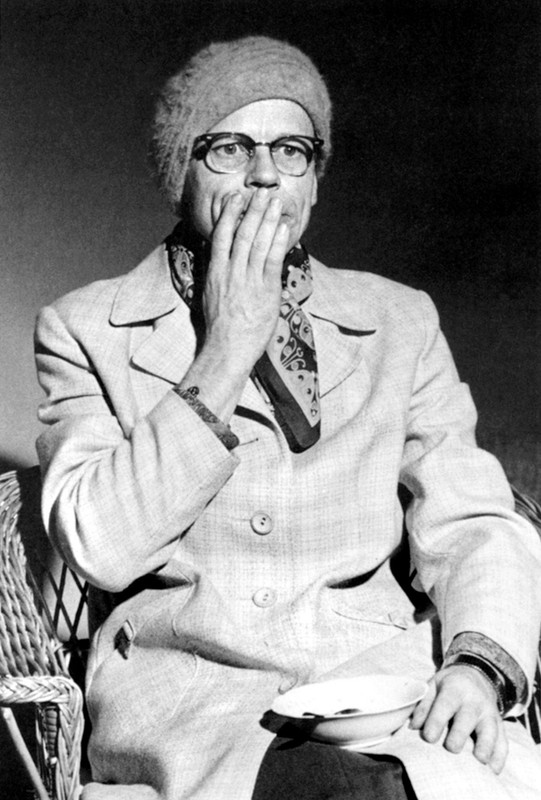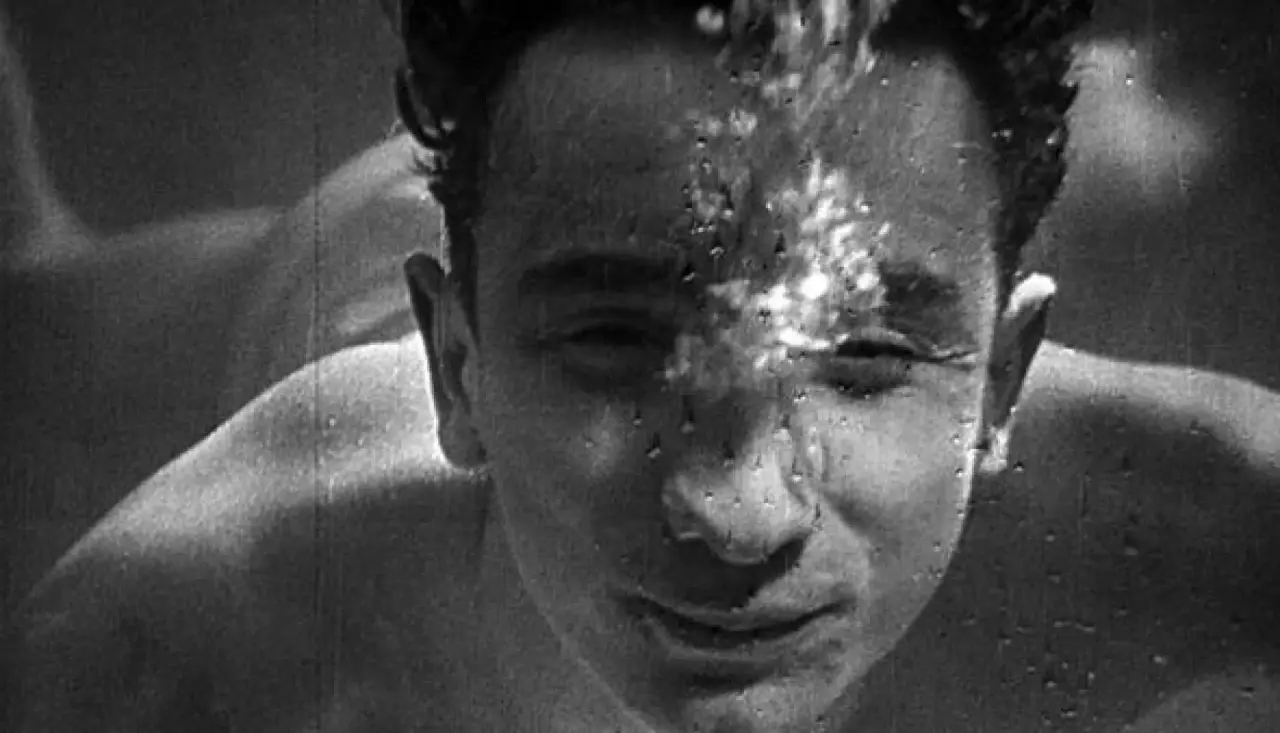“I don't want to imitate nature. I want to capture its very essence. As if all the birds and the beasts die tomorrow and the world became a desert, when people heard my music – they would still know, feel, what nature was.”Mahler (Ken Russell, 1974)
Nov
12
World Pneumonia Day

Gustav (Robert Powell) and Alma (Georgina Hale), both in a three piece suit with top hats. She's in a shadows, wearing a tight, black veil that completely conceals her features. DP: Dick Bush.
A sickly #GustavMahler (Robert Powell) and his wife Alma (Georgina Hale) dwell on their shared lives while travelling to Vienna by train. Storylines – circular like a journey, rondo like #Mahler's compositions – drift from the ordinary to the grotesque.
– Gustav Mahler
This would be the composer's final tour. A train took him to a Vienna sanatorium where not much later he'd succumb to #pneumonia.
biography
کلوزآپ ، نمای نزدیک [Klūzāp, nemā-ye nazdīk / Close-Up] (Abbas Kiarostami, 1990)
Nov
8

Hossain Sabzian as himself. He sits behind a low table holding various refreshments, presented by his host. DP: Ali Reza Zarrindast.
U bent mijn moeder (Horst Königstein, 1984)
Sep
21
World Alzheimer's Day

Joop Admiraal in the role of his mother. During the monologue, the actor switches character and props.
“Prison is good for the good and bad for the wicked. It teaches the good a lesson but only makes the wicked worse.”کلوزآپ ، نمای نزدیک [Klūzāp, nemā-ye nazdīk / Close-Up] (Abbas Kiarostami, 1990)
Sep
8
Pardon Day

Hossain Sabzian riding passenger on a motorcycle holding a large potted rose-red dahlia. DP: Ali Reza Zarrindast.
کلوزآپ ، نمای نزدیک is visual narrative illustrating a crime. A cinephile, Hossain Sabzian, pretends to be filmmaker Mohsen Makhmalbaf and slowly extorts a family into believing to star in the director's next film.
– Hossain Sabzian
An article about the case intrigued director #Kiarostami so much that he decided to film the court case against Sabzian, and ask the accused, Makhmalbaf, and the Ahankhah family to reenact some of the events.
“Speed is the ultimate, all-time high. That first rush. Wow! Just that burning, searing, soaring sense of perfection.” Ciao Manhattan (John Palmer + David Weisman, 1972)
Aug
31
International Overdose Awareness Day

A hollow-eyed Susan Superstar (or Edie Sedgwick, it doesn't matter) getting ready in the morning in one of the 1960s scenes. The cameraman is visible in the many bathroom mirrors. DPs: John Palmer & Kjell Rostad.
28 is no age to die, regardless if your name is Susan Superstar or Edie Sedgwick. But it happened, right during the wrap-up of Ciao Manhattan. Edie was gone, just like that, snuffed like so many of the other #Warhol Superstars. What did remain was footage, so much abandoned footage shot in the 60s when those stars were shining at their brightest. That footage, set in glitzy black-and-white Manhattan, is where Edie and Paul America race around town on amphetamine. Or see a doctor to get shots of some sorts.
– Susan
And there's colour footage too. Susan, topless, semi-(un)consciously dragged around the floor of her empty pool-turned-Superstar-temple. She babbles, drinks, dances around in her panties. And she ODs. Like Edie would even before this movie had seen the light of day.
They snuff so fast, these bright Superstars.
“There are never enough hours in the days of a queen, and her nights have too many.” Cleopatra (Joseph L. Mankiewicz + Rouben Mamoulian, 1963)
Aug
26
National Spark The World Day

Cleopatra's – Elizabeth Taylor, anachronistically dressed as the goddess Nekhbet – grande entrée in Rome. She sits on top of a black, basalt-like sphinx, pulled by numerous slaves and greeted by a cast of thousands. There are 20 000 Italian extras; there's no CGI. DPs: Leon Shamroy & Jack Hildyard.
Like Rome, Cleopatra wasn't built in a day. Joseph L. Mankiewicz's epic studio breaker took six years to make and, despite it being the highest-grossing film of 1963, didn't break even until 1973. Was it a #flop? A classic flop but a flop nevertheless?
– Cleopatra
The star – the Queen – Elizabeth Taylor demanded an unprecedented one million dollar fee, 10,3 million in 2023 US dollars. Liz's movie dressing table hold trinkets especially designed by luxury brand Bulgari, blink and you'll miss them. The Pharaoh's lavish costumes, all 65 of them (created by Irene Sharaff who would dress Taylor again as #Cleopatra's counterpart Martha in Who's Afraid of Virginia Woolf? (1966)), cost almost 195K dollar (ca. 2 million today), and of course those 20 000 extras, shipped from God-knows-where to Hollywood on the Tiber to shoot one scene, had to look like their 2000 year old counterparts, and be fed, and housed.
Is it all bad? Cleopatra is one of those movies that so many – and that includes obsessive cinephiles – will get around to watch. Eventually. All four hours of it. I'm still holding out, but ooh, the spectacle!
Glen or Glenda (1953)
In an intimate moment, Barbara (Dolores Fuller) hands Glen (Ed Wood) her angora sweater. DP: William C. Thompson.

August 25: someone wears another person's clothes on #NationalSecondhandWardrobeDay
Glen or Glenda [aka Male or Female aka Glen or Glenda, Which Is It? aka I Led 2 Lives] (Edward D. Wood Jr., 1953)
“Give this man satin undies, a dress, a sweater and a skirt, or even the lounging outfit he has on, and he's the happiest individual in the world. He can work better, think better, he can play better, and he can be more of a credit to his community and his government because he is happy.” —Dr. Alton, narrator
In 1953, Christine Jorgensen – who had widely reported sex reassignment surgery the year before – was approached by schlocky Z movie producer George G. Weiss to be in an exploitation movie about her voyage. She kindly thanked for the offer. Who did bite was the producer's pick to be the director, novice movie maker and transvestite Edward D. Wood Jr.. Wood reworked the script.
The resulting effort – Glen or Glenda – is not only an utterly unique autobiographic docudrama; it's a lovingly composed pamphlet in support of (heterosexual) transvestism – both fetish and lifestyle, not to be confused with drag – and transsexualism to boot. Rarely sex-related outsider lifestyles were discussed this frankly; Kinsey's Sexual Behavior in the Human Male came out only five years prior and the volume about the human female in the year of this movie.
It's also pretty unique when it comes to the art of filmmaking. However contagiously enthusiastic, Wood didn't have the skill, weight, or budget to make movies. He'd pad story lines and plot holes with stock footage and long-winded dream sequences of the sexploitation kind. Like John Waters after him, Ed would cast friends and family – Dolores Fuller was his real-world girlfriend – and cinematic idols such as Bela Lugosi, who by 1953 was addicted to alcohol and prescription drugs.
Wood's life was wild and colourful. He once said that while serving in the US Marine Corps, he feared injury more than death, worried that the combat medic would discover the pink bra and panties under his uniform. It makes me wonder if the full colour promotional material for Psycho (1960) was #Hitchcock sending out a little wink to Ed.
Marion Crane (Janet Leigh) wearing pink undergarments on a lobby card for Psycho (1960). The movie itself is in black and white and the reveal of Marion wearing pink underwear came as a shock in early-60s prissy America. DP: John L. Russell.
#Bales2023FilmChallenge #EdwardDWoodJr #BelaLugosi #LyleTalbot #DoloresFuller #ConradBrooks #WilliamCThompson #fashion #angora #crossdressing #sweaters #LGBT #fetishism #drag #docudrama #biography #USA #1950s
“The reality is that we do not wash our own laundry; it just gets dirtier.”Serpico (Sidney Lumet, 1973)
Jul
30
National Whistleblower Day

The cover of the Austrian film magazine “Neues Filmprogramm”. A red-filtered lobby card of Frank Serpico (Al Pacino) and his partner (F. Murray Abraham, uncredited) during police proceedings. DP: Arthur J. Ornitz.
In the late 1960s, Frank Serpico worked as a plainclothes cop for the #NYPD. He spoke out when he uncovered systematic, widespread #corruption within the force, but his findings were ignored. In 1970, Serpico cowrote a page 1 article for the New York Times about the problem, which led to the instalment of the Commission to Investigate Alleged Police Corruption aka the Knapp Commission.
– Frank Serpico
The following year during a drug-related arrest attempt, he was shot in the face under shady circumstances. This is where Sidney Lumet's Serpico, based on Peter Maas and Frank Serpico's book of the same name, starts.
“You say to the boy 'Open your eyes'. When he opens his eyes and sees the light, you make him cry out, saying 'Oh, Blue, come forth! Oh, Blue, arise! Oh, Blue, ascend! Oh, Blue, come in!'.”Blue (Derek Jarman, 1993)
Jul
13
Oxymoron Day

Not a screenshot from the film, but a pure representation of International Klein Blue.
Synchronous to the screening of a film that wasn't, Derek Jarman's Blue was broadcast on radio and television. Those who tuned into the radio could request a special card printed in that most spectral of colours, International Klein Blue, a blue that according to its creator Yves Klein, has “a quality close to pure space” and “immaterial values beyond what can be seen or touched”.
– Nigel Terry
Submerged in #blue, seeing through what was left of Jarman's eyes, we live through the artist's life, and love, and loss. When you leave the theatre, put down that card, you're temporarily blinded by the physiological afterimage of a devastating disease. What remains is the voice of a filmmaker who lost his sight.
Taris, roi de l'eau [Taris, King of the Water] (Jean Vigo, 1931)
Jul
12
freebie: Swim A Lap Day

Jean Taris in his element. DP: Boris Kaufman.
A proto-Jean Painlevé exercise avant la lettre.
